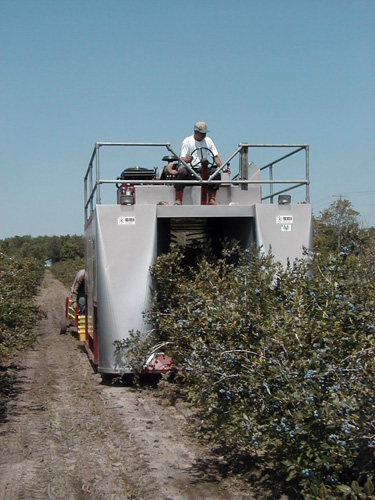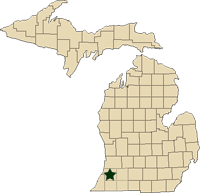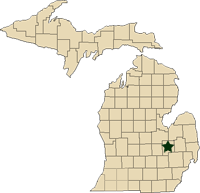Regional reports on Michigan fruit - August 16, 2011
MSU Extension educators’ pest and fruit updates for Michigan
This week’s regional reports:
- Southwest Michigan - Mark Longstroth, Bill Shane, Diane Brown
- Southeast Michigan - Bob Tritten
Southwest Michigan – Mark Longstroth, Bill Shane, Diane Brown, Michigan State University Extension
|
Last week’s weather was cooler and dry with highs in the upper 70s and lows in the 50s. Pulses of storms moved across the region Saturday, August 13. Rainfall was over 2 inches north of I-94, but most areas received less than a half-inch. Soil conditions range from wet to dry. This week is forecast to have highs in the 80s and lows around 60. The region is ahead of normal for heat accumulation (GDD), but because of the cool, wet spring, fruit harvest appears to be about five days later than predicted for apples and peaches. Find the closest Enviro-weather station near you by going to www.enviroweather.msu.edu.
|
Southwest Michigan Growing Degree Day Totals from March 1 through August 14, 2011 |
|||
|
Location |
GDD 42 |
GDD 45 |
GDD 50 |
|
2972 |
2596 |
2017 |
|
|
2788 |
2427 |
1867 |
|
Tree fruit
There have been no reports of brown marmorated stink bugs in the area this year.
In peaches, Red Haven harvest continues. Other varieties being harvested include Starfire, Redstar, Bellaire, plus Flamin’ Fury varieties PF 9 A-007, PF 11 Peach, PF Lucky 13 and PF 15 A. Harvest is delayed from our predicted dates and growers should be monitoring peach fruit for the desired ripeness. Brown rot infections are a problem in some orchards. Heavy infections seen on scattered individual trees are generally due to early green fruit infections that initiated abundant spore production early in the season. The third generation of oriental fruit moth should be flying, beginning at about 2,200 to 2,400 GDD base 45, and numbers have begun to rise in some orchards we trap.
In cherries, cherry leaf spot continues to defoliate trees. Mature cherries can be pruned until early September.
Plum harvest continues. Vibrant and Ozark Premium plums are finishing, other varieties being harvested include Vanette and Voyageur. Stanley plums are coloring. Plums should be protected from brown rot and apple maggot. White apple leafhoppers will also attack plum leaves, causing white speckling on the leaves.
In apples, Pristine harvest is done in most sites. Paula Red, Zestar and Early Mac harvest is starting. We are about four to five days later than the predicted apple harvest dates. With apple scab spreading to new leaves and the summer diseases of sooty blotch and fly speck, fungicides should be included in late season cover sprays. The third generation of oriental fruit moth should be flying and the second generation of codling moth is ending, although it was still high at several locations we trap. Flight of the summer generation of obliquebanded leafroller has begun and apple maggot flies are out. The treatment threshold for European red mite is seven mites per leaf. Heavy populations of green apple aphid can still be found on suckers and shoots tips.
Pear fruit are 2.5 inches in diameter. Bartlett harvest is expected to begin at the end of this week. Few pear psyllas were observed in the orchards we scout, populations are generally light. Second generation codling mothis a concern in pears and growers should be treating for this generation.
Small fruit
Japanese beetle numbers are declining. Look for them congregating in preferred feeding areas. Spotted wing Drosophila flies have been caught in Allegan, Van Buren and Ottawa counties.
Grapes are nearing veraison and color is visible in early varieties, but is not visible in Concord. Niagara harvest is forecast to begin on September 16 and Concord about 16 days later. The third generation grape berry moth is flying, but trap catch numbers are low. Grape berry moth has ranged from 4 to 33 percent of clusters infested for the vineyards we sample. The damage we found was individual berries in clusters and we did not find multiple berries webbed together. Traditionally, we do not catch a lot of adults late in the season, but continue to see lots of damage. Trap counts are not a good indication of the population.
Powdery mildew has been reported in a few locations on wine grape varieties. Daily heavy dews are ideal for downy mildew development and growers should plan their fungicide applications accordingly. Downy mildew is defoliating unsprayed research plots, but in commercial vineyards, downy mildew seems to be under control. In the unsprayed grape sentinel plot at the Southwest Michigan Research and Extension Center, berries of the variety ‘Chancellor’ are heavily infected (near 100 percent), and infection in ‘Vignole’ berries is increasing. No major damage from grape leafhoppers and potato leafhoppers has been reported. There is still time to do tissue testing for grapes, which are normally samples at veraison.
Blueberry harvest continues across the region. Fruit cracking from rain and soft fruit from delayed harvest are problems for some. Machine harvest of Bluecrop is ending Jersey and Rubel, and other varieties are being machine harvested. Yields in Jersey are all over the board. Some growers have good yields and are now in their second or third pickings, while others skipped Jersey and moved directly into Elliotts. Hand harvest crews are scarce and smaller growers report that labor is hard to find. We are at the end of the window for taking leaf samples for tissue analysis.

Blueberry Harvester
Cane collapse from phomopsis cane blight continues, but has not been as severe as in recent years, or as severe as I would have expected from the cane dieback visible this spring. Insects of concern include Japanese beetles and blueberry maggots. Abandoned and poorly sprayed fields are infested with blueberry maggot and this fruit is unsellable. Anthracnose remains the most common fruit rot in ripening fruit. Harvest sprays should protect fruit from maggot, anthracnose and alternaria.
Strawberry fields are generally growing well and running, except where potato leafhoppers have stunted growth.
In brambles, blackberry and fall raspberries harvest continues. Heavy morning dews can make gray mold a problem. Spider mites may also be an issue, especially in high tunnels. Growers should take time to assess injury levels and treat accordingly.
Southeast Michigan – Bob Tritten, Michigan State University Extension
|
Weather
We have had many rain showers move through the region over the last week, with most farms receiving between 0.75 and 1.25 inches of precipitation. We have had a few growers that have received rainfall totals in the 2- to 3-inch range. Almost all these rains have been from thundershowers that have been widely scattered across the region.
Overall, our soil moisture supply is slowly being replenished from recent beneficial rain events. Tree fruits and small fruits that have been showing signs of drought stress are looking much better. This recent rainfall is also helping to size peaches and later varieties of blueberries.
Our season is still running close to a week ahead of normal in terms of degree days. However, when I look at the beginning of harvest for our fruit crops, some are behind normal (Red Haven peaches) and some are ahead (fall red raspberries). This doesn’t make sense horticulturally, but there are many things that don’t make sense this season.
|
Southeast Michigan Growing Degree Day Totals for March 1 to August 15, 2011 |
|||
|
Location |
GDD42 |
GDD45 |
GDD50 |
|
2905 |
2543 |
1979 |
|
|
2839 |
2480 |
1925 |
|
|
Flint (Genesee) |
2899 |
2532 |
1970 |
|
2889 |
2527 |
1967 |
|
|
3074 |
2697 |
2109 |
|
|
2672 |
2322 |
1783 |
|
|
2920 |
2561 |
2004 |
|
Tree fruits
Apples continue to size quite nicely with most being in the range of 2.75 to 3 inches in diameter. Progress in summer pruning has been very good at most farms across the region, with favorable weather and adequate labor supplies.
In the last week I have had many inquiries from apple growers asking about maturity of Paula Red and Gingergold. In the harvest dates that I originally published in July, I indicated that our season was running just a few days behind normal. It now appears that apple harvest is running close to a week behind normal. So, I would expect to see Paula Red harvest the last few days of August or the first few days of September and Gingergold to follow that by a few days.
Apple maggot trap catch continues at about the same pace across the region, with all of the trap catch occurring on yellow sticky board traps and none again this week on red sphere traps. The question that apple growers often have about apple maggot at this time of the season is relative to a point of time when they are no longer able to lay viable eggs in fruit. Typically in east Michigan this occurs in mid- to late August. My recommendation to growers this season, based on recent trap catches and knowing where we are at in the season, is that most likely one more insecticide cover is needed to continue to control apple maggot through harvest.
Codling moth trap catches are down this week, as are oriental fruit moth trap catches. San Jose scale males continue to be caught in traps; however, we are beyond the crawler stage. Woolly apple aphid populations have pretty much been controlled at most farms, with fewer clusters of woolly’s now being seen. Japanese beetle populations are on wind down for the season. European red mites have caused bronzing in a few hot spots. Most growers have chosen to let predators continue to feed on European red mites. Two-spotted spider mite and apple rust mite numbers are very high in some isolated locations or hot spots in orchards, however I have not seen populations high enough that control measure needs to be applied. I continue to see a good number of predators, most notably lace wing adults and eggs. Lady bugs continue to be seen, however their numbers are declining due to a lack of food for them.
I have not seen sooty blotch or fly speck, but I continue to be on the lookout for it. I expect that the first sighting will be much later this year due to the lengthy drought at most fruit farms.
Pears continue to size quite nicely with most being close to 2.5 inches in diameter. Many pear growers have asked about the ripening or maturity of pears, as Bartlett’s are typically harvested the first week of September. I think that pear harvest will be a week later than normal this year.
Peach harvest continues with pre-Red Haven varieties. Red Havens are ripening very slowly this year, at least a week behind normal. Red Havens are still clinging very hard to the pit, have poor flavor, and are not quite ready yet. Oriental fruit moth populations are on the decline in peaches as well. There appears to be a touch of split pit in Red Haven this season.
Sweet and tart cherry leaf drop has been slowed from post-harvest fungicide applications made over the last few weeks.
Plums continue to size well. European plums are coloring well; this started last week and is definitely more intense this week.
Small fruit
Strawberries continue to grow quite nicely from the renovation process. New plantings are filling in the rows well. Most growers have done a good job of scouting for and controlling potato leafhoppers in new plantings over the last two weeks. I see that most plantings are recovering quite nicely from earlier infections of leafhoppers.
Weed control continues to be an issue for many growers, as problem weeds seem to be breaking through earlier herbicide applications and weeds typically controlled at renovation did not seem as they took up as much herbicide as what they normally do, and therefore are still quite viable. I have had conversations with a number of growers about reapplication of herbicides and hand weeding.
Raspberry harvest continues for fall bearing red raspberries. Many farms are now open on a regular basis for pick-your-own sales. Japanese beetle populations are on the decline.
Blueberry harvest continues across the region, with many farms reporting that they are struggling with berry size. While most farms are experiencing good blueberry yields this year, we also have other farms that are finding that their crop is down almost by half this year. Blueberry maggot continues to be caught on yellow sticky board traps. Birds continue to be a serious feeding problem at many blueberry farms.
Grapes continue to size nicely. Grape berry moth adult flight is winding down for the second generation. I am now seeing grape berry moth larvae that are feeding in grape clusters. Growers need to do a good job of scouting for grape berry moth larvae.



 Print
Print Email
Email





